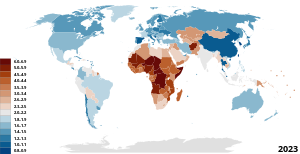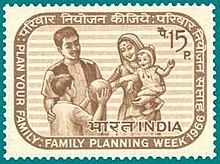
Back تنظيم الأسرة في الهند Arabic இந்தியாவில் குடும்பக் கட்டுப்பாடு Tamil ہندوستان میں خاندانی منصوبہ بندی Urdu


Family planning in India is based on efforts largely sponsored by the Indian government. From 1965 to 2009, contraceptive usage has more than tripled (from 13% of married women in 1970 to 48% in 2009) and the fertility rate has more than halved (from 5.7 in 1966 to 2.4 in 2012), but the national fertility rate in absolute numbers remains high, causing concern for long-term population growth. India adds up to 1,000,000 people to its population every 20 days.[1][2][3][4][5] Extensive family planning has become a priority in an effort to curb the projected population of two billion by the end of the twenty-first century.
In 2016, the total fertility rate of India was 2.30 births per woman[6] and 15.6 million abortions performed, with an abortion rate of 47.0 abortions per 1000 women aged between 15 and 49 years.[7] With high abortions rates follows a high number of unintended pregnancies, with a rate of 70.1 unintended pregnancies per 1000 women aged 15–49 years.[7] Overall, the abortions occurring in India make up for one third of pregnancies and out of all pregnancies occurring, almost half were not planned.[7] On the Demographic Transition Model, India falls in the third stage due to decreased birth rates and death rates.[8] In 2026, it is projected to be in stage four once the Total Fertility Rate reaches 2.1.[8]
- ^ Rabindra Nath Pati (2003). Socio-cultural dimensions of reproductive child health. APH Publishing. p. 51. ISBN 978-81-7648-510-4.
- ^ Marian Rengel (2000), Encyclopedia of birth control, Greenwood Publishing Group, ISBN 978-1-57356-255-3, archived from the original on 7 October 2015, retrieved 1 February 2016,
... In 1997, 36% of married women used modern contraceptives; in 1970, only 13% of married women had ...
- ^ Cite error: The named reference
who2009gdjwas invoked but never defined (see the help page). - ^ Cite error: The named reference
ramu2006was invoked but never defined (see the help page). - ^ Cite error: The named reference
bucen1997ahswas invoked but never defined (see the help page). - ^ "ESTIMATES OF FERTILITY INDICATORS" (PDF). data.worldbank.org. Archived (PDF) from the original on 19 August 2020. Retrieved 19 January 2020.
- ^ a b c Singh, Susheela; Shekhar, Chander; Acharya, Rajib; Moore, Ann M; Stillman, Melissa; Pradhan, Manas R; Frost, Jennifer J; Sahoo, Harihar; Alagarajan, Manoj (1 January 2018). "The incidence of abortion and unintended pregnancy in India, 2015". The Lancet Global Health. 6 (1): e111–e120. doi:10.1016/S2214-109X(17)30453-9. ISSN 2214-109X. PMC 5953198. PMID 29241602.
- ^ a b "Trends in Demographic Transition in India - General Knowledge Today". www.gktoday.in. Archived from the original on 12 April 2018. Retrieved 12 April 2018.
© MMXXIII Rich X Search. We shall prevail. All rights reserved. Rich X Search